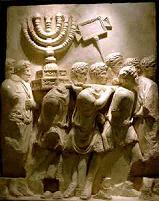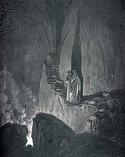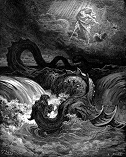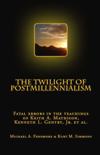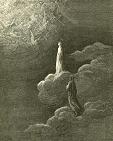The Christian’s Destiny and the New Creation
© MEV Publications,
July 2000
Contact the author: berean.spirit@gmail.com
What is our ultimate hope and destiny as believers in the Lord Jesus Christ? Where do we go when we die? Do we spend eternity in heaven? What does St John’s vision of the New Jerusalem represent? With what sort of bodies will we be raised?
St John’s vision of the New Jerusalem
John’s vision in Revelation 21–22 has led some to suppose that our ultimate destiny is to inhabit a renewed material creation. But this to seriously misconstrue John’s vision! Our present aim is to examine carefully his vision, both its context and its symbolism. A correct perspective will show that the New Jerusalem cannot possibly represent our final abode.
In the first instance, note carefully John’s time-indicators:
The revelation of Jesus Christ, which God gave him to show his servants WHAT MUST SOON TAKE PLACE... blessed are those who hear it and take to heart what is written in it, because THE TIME IS NEAR. (Revelation 1:1, 3)
“The Lord… sent his angel to show his servants THE THINGS THAT MUST SOON TAKE PLACE… Do not seal up the words of the prophecy of this book, because THE TIME IS NEAR.” (Revelation 22:6, 10)
John is absolutely clear: His vision concerned events that would ‘soon take place’. In other words, events of the first century!
Consider the context. Written probably in 63 AD, the book of Revelation was given to comfort and strengthen Christians in the province of Asia who would soon face brutal persecution from the Roman authorities. Opposition had already come from the ‘synagogue of Satan’ (Rev 2:9; 3:9) — unbelieving Jews in Asia — but soon, the emperor Nero would cause vast numbers to be martyred. The book is a prophecy of Christ’s judgments on their persecutors and especially on the ‘Harlot’. It’s not about nuclear war, and it’s not primarily addressed to 21st century believers!
Who is this Harlot? John calls her ‘Babylon’ and ‘the great city’ (Rev 17:5; 18:21). This same city is earlier called ‘Sodom and Egypt’ and identified by John as Jerusalem:
The street of THE GREAT CITY, which is figuratively called Sodom and Egypt, WHERE ALSO THEIR LORD WAS CRUCIFIED. (Revelation 11:8)
So you see, Revelation speaks of two women who are two cities and both are Jerusalem! But they differ radically: One is the old earthly city, the other a new spiritual ‘city’. One is an unfaithful and persecuting ‘Harlot’ (Rev 17:5-6; 18:24; cf. Mt 23:35-37); the other is Christ’s faithful ‘Bride’ (Rev 21:2, 9).
Now what’s all this about? Simply this: The Jews, in crucifying Christ and persecuting His followers, had demonstrated their rejection of God Himself and of their covenant partnership (their ‘marriage’) with Him. So God would punish these ‘adulterers’. Hadn’t Jesus earlier foretold Jerusalem’s ruin (Lk 21:20-24; Mt 22:7)? John’s visions of judgment would soon be fulfilled in the 70 AD Roman siege and destruction of the city.
Believing Jews and Gentiles, on the other hand, were citizens of the ‘heavenly Jerusalem’ (Heb 12:22; Gal 4:26). But note this: John sees the city ‘coming down out of heaven from God’ (Rev 21:2, 10). The New Jerusalem is on earth! How so? First, the city is the Church — Christ’s ‘holy and blameless’ new bride (Eph 5:27). And second, the city pictures our spiritual privileges in Christ. It’s where we ‘live’ under the New Covenant. Though on earth, the justified believer is legally as much a citizen of heaven as are the angels and perfected saints (Heb 12:22-23).
John’s vision of the two ‘Jerusalems’ portrays God’s expulsion of national Israel (the Harlot) from His covenant and His taking for Himself a new covenant partner — the Church. That the New Jerusalem depicts present, spiritual realities seems obvious from John’s description.
First, ‘Nations’ are present in the New Creation:
The nations will walk by its light, and the kings of the earth will bring their splendor into it. (Revelation 21:24)
Furthermore:
The leaves of the tree [of life] are for the healing of the nations. (Revelation 22:2)
Is there ‘healing’ in eternity? Isn’t this rather a picture of the effects of the gospel, with the nations being progressively healed as they are won for Christ?
Second, the wicked, also, are present in the New Creation. They dwell outside the city’s walls, excluded from its privileges:
Outside [the city] are the dogs, those who practice magic arts, the sexually immoral, the murderers, the idolaters and everyone who loves and practices falsehood. (Revelation 22:15)
Though excluded, an invitation extends to them. Together, Church and Spirit continually invite the wicked to repent and to enter the city’s gates to partake of the water of life. These gates are never shut (Rev 21:25). What a marvellous picture of the gospel invitation to sinners!
Blessed are those who wash their robes, that they may have the right to the tree of life and may go through the gates into the city… The Spirit and the bride say, “Come!”... Whoever is thirsty, let him come; and whoever wishes, let him take the free gift of the water of life. (Revelation 22:14, 17)
Third, the shape of the New Jerusalem is significant: The city is a perfect cube (Rev 21:16). What does this signify? Simply this: The New Jerusalem is modelled on the Most Holy Place of the Temple. For that inner sanctuary, where God dwelt behind the curtain, was likewise a cube (1Ki 6:20; Eze 41:4). Under the Old Covenant, access to God was restricted to the high priest once a year — ordinary priests ministering in the outer room were excluded (Heb 9:6-8). But all of this changes under the New Covenant. The curtain is removed, and all believers are priests who have full, unrestricted access to the Father (Mt 27:51; Rev 1:6; 5:10; Heb 10:19-22). They constantly serve before God’s throne; they ‘see His face’ (Rev 7:15; 22:3-4). He dwells with them in fulfilment of His covenant promise (Rev 21:3; cf. 2Co 6:16; Lev 26:11-12; Eze 37:27).
Fourth, John’s vision shows creation restored: No more curse or death or crying or pain (Rev 21:4; 22:3); no more banishment from God’s presence (Rev 22:4); access to the tree of life restored (Rev 22:14). All these are symbols of our spiritual blessings in Christ. The ‘river of the water of life, as clear as crystal’ that proceeds from God’s throne is a picture of the pure gospel that cleanses from sin and supports the life of the city (Rev 22:1; cf. Jn 4:10-14; 6:35; Rev 7:16-17; 21:6; 22:17).
Fifth, the New Creation pictures the kingdom of Christ on earth. Christ’s kingdom — His universal and eternal reign of peace and justice — was imminent (Rev 11:15; cf. Ps 2:8-9; Da 7:14, Lk 1:33; Isa 9:7; 11:3-9). Hadn’t Jesus spoken of the kingdom as ‘near’ (Mt 4:17) and as something that would come ‘with power’ in that generation (Mk 9:1; Lk 21:31-32; Mt 16:28)? Moreover the saints themselves, who would endure and live through the coming trial, would share in their Lord’s rule (Rev 22:5; cf. 2:26-27; 3:21; 5:10; Da 7:17-27). How do the saints now reign? What is their royal task? Answer: To mould and shape the world through proclaiming the gospel; to be salt and light (Mt 5:13-16; Rev 21:24).
Sixth, the prophet Isaiah foretold the New Creation, along with a restored Jerusalem whose citizens would enjoy procreation and longevity, building and planting, and edenic tranquility (Isa 65:17-25). When would this happen? Answer: During the righteous reign of the Messiah (compare Isaiah 65:25 with 11:6-9).
Finally, the apostle Peter foretold the New Creation and viewed it as imminent. For Peter, the ‘fiery trial’ his readers were undergoing (1Pe 4:12, KJV and ESV; cf. 1:6-7) was proof that the Judgment had begun and ‘the end of all things’ was ‘near’ (1Pe 4:5, 7, 17). Thus he could urge his first century readers to eagerly await — and even to ‘speed’ — the coming of the ‘day of God’ and the ensuing New Creation (2Pe 3:12-14).[1]
The Christian’s ultimate destiny: Heaven
Since the New Jerusalem symbolises our spiritual privileges this side of eternity, it’s obvious that our final destiny must lie elsewhere. The New Testament is actually quite clear: Our ultimate hope is to dwell eternally with Christ in heaven. Listen to what the apostle Paul says:
Now we know that if the earthly tent we live in is destroyed, we have a building from God, an ETERNAL HOUSE IN HEAVEN, not built by human hands. Meanwhile we groan, longing to be clothed with our heavenly dwelling, because when we are clothed, we will not be found naked. For while we are in this tent, we groan and are burdened, because we do not wish to be unclothed but to be clothed with our heavenly dwelling, so that what is mortal may be swallowed up by life... Therefore we are always confident and know that as long as we are at home in the body we are away from the Lord... We are confident, I say, and would prefer to be away from the body and at home with the Lord... So we make it our goal to please him, whether we are at home in the body or away from it. For we must all appear before the judgment seat of Christ, that each one may receive what is due him for the things done while in the body, whether good or bad. (2 Corinthians 5:1-10)
Though Paul’s earthly body (his ‘tent’) would be destroyed, in heaven he would be clothed with his final resurrection body — his ‘eternal house’ (vs. 1). He would be ‘at home’ with the Lord.
Note that Paul seems to be anticipating receiving his new body immediately at death. He longs not to be found ‘naked’ or ‘unclothed’ but to be directly clothed with his new body. But that raises an intriguing question: How could Paul receive his resurrection body prior to the Resurrection itself?
John’s vision in Revelation 20 clarifies both the timing and the nature of the Resurrection. As noted earlier, his vision concerned events that were imminent. The Resurrection itself was one of those ‘things that must soon take place’ (Rev 22:6). As to its nature, John shows all the dead leaving Hades to appear before God’s judgment throne in heaven (Rev 20:11-15). Therefore, in the Resurrection souls were released from Hades, not bodies from graves (Rev 1:18; cf. Jesus’ figurative description in John 5:28-29). The resurrected saints received not again their former earthly bodies, but new, spiritual bodies suited to the heavenly realm (1Co 15:44-50).
Because under the Old Covenant sin was not effectively dealt with, no one who died could enter heaven. Instead, the souls of the righteous entered Hades-Paradise (Lk 16:22; 20:38; 23:43). Then finally in 70 AD the temple was destroyed and the Old Covenant rendered ‘obsolete’ (Heb 8:13) — access to God had been restored! Those in Paradise were raised to heaven with their new bodies. The wicked in Hades-Tartarus (Lk 16:23; 2Pe 2:4) were condemned to the Lake of Fire (Rev 20:15).
Paul, along with other New Testament authors, knew that this ‘Last Day’ Resurrection was imminent (Php 4:5; Heb 10:25; 1Pe 4:7; 1Jn 2:18; cf. Jn 6:39-40). In just a few short years, the saints in Paradise would rise. Thereafter, those on earth would enter heaven directly when they died. Paul lived on the threshold of the new age and spoke as if it were already present. He assumed that some at least to whom he wrote would remain alive until the Resurrection (1Co 15:51; 1Th 4:15-17).
In summary, with the Resurrection of 70 AD long past, believers put on their resurrection bodies individually when they die. Heaven itself is our final home. There, in our spiritual bodies, we live in the presence of the Lord Jesus forever.
[1] Peter’s description of the world’s fiery destruction (2Pe 3:7-12) referred to the imminent end, not of the habitable globe, but of the old religious and political order as Christ brought His judgments to bear on Jerusalem and upon the entire Roman world.
To receive Kurt Simmons’ e-mail newsletter, The Sword & The Plow, click the Subscribe link:
All rights reserved.
